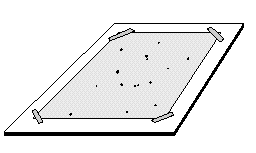Clear contact paper (14 centimeters
square)
Graph paper (reproduce copies of
the graph paper provided with the
activity)
Cardboard or 1/4 inch plywood (40
centimeters square)
Cellophane tape
Magnifying glass
Dice
Procedure:
1. Tape the graph paper to the center of the cardboard. Tape the contact paper on top of the graph paper with sticky side up. Keep the protective backing on the contact paper.
2. Place the pollution sampler outside on a flat surface, preferably a meter or two above the ground. You may have to anchor the sampler if the air is windy. Remove the protective backing. Make sure the contact paper is firmly taped down on the cardboard.
3. After exposing the sampler to the outside for twenty-four hours, place the graph paper over the collecting surface, grid side down, and return the sampler to school.*
4. Remove sampler from the cardboard and observe the particles from the back side of the clear Contact Paper. Using the magnifier, count the number of particles found in each of ten randomly selected squares on the graph paper grid. Select

the squares by tossing the dice. If the numbers come up two and five, for example the square is found in the second column, fifth row. Divide the total number of particles counted by 10 to get an average number per square. Each square is two centimeters on a side.
5. Compare the average particle counts to
the locations where the collectors were
placed (proximity to farms, factories,
freeways, etc.). Add the average particle
count for all samplers together and divide
by the total number of collectors to obtain
a regional average for the two-centimeter
square. Using this average, calculate the
total number of particles for one square
kilometer of area centering on the school.
What would the count be for ten square
kilometers?
* Depending upon local conditions, a longer sampling
period may be required.
Discussion: Even on a clear night, many small particles are present in the atmosphere. Dust par-ticles are lofted into the air by wind and other particles are produced as combustion products from cars, fire places, industry,
